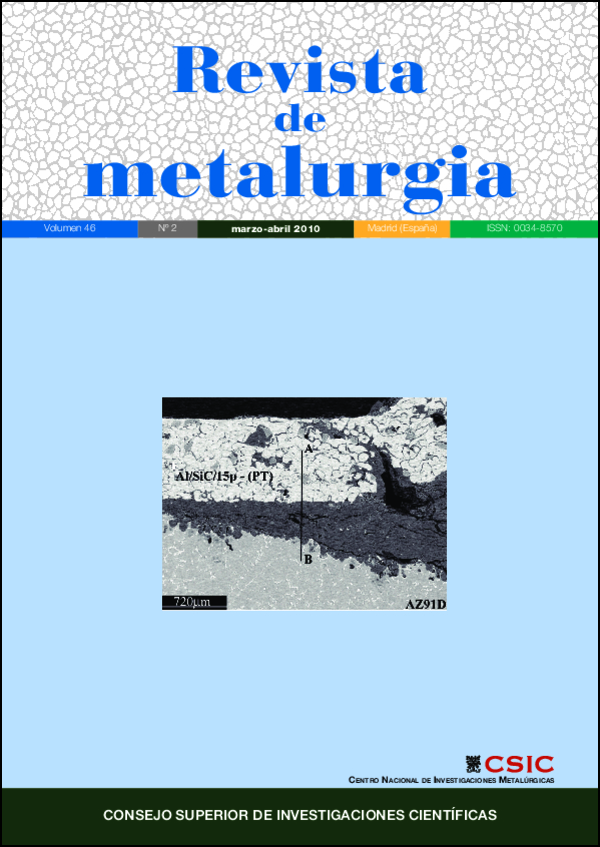Deformation induced martensite in AISI 316 stainless steel
DOI:
https://doi.org/10.3989/revmetalm.0920Keywords:
Plastic deformation at low temperature, Austenitic stainless steel, Strain-induced martensitic transformation, Numerical simulationAbstract
The forming process leads to a considerable differentiation of the strain field within the billet, and finally causes the non-uniform distribution of the total strain, microstrusture and properties of the material over the product cross-section. This paper focus on the influence of stress states on the deformation-induced a’ martensitic transformation in AISI Type 316 austenitic stainless steel. The formation of deformation-induced martensite is related to the austenite (g) instability at temperatures close or below room temperature. The structural transformation susceptibility is correlated to the stacking fault energy (SFE), which is a function not only of the chemical composition, but also of the testing temperature. Austenitic stainless steels possess high plasticity and can be easily cold formed. However, during cold processing the hardening phenomena always occurs. Nevertheless, the deformation-induced martensite transformation may enhance the rate of work-hardening and it may or may not be in favour of further material processing. Due to their high corrosion resistance and versatile mechanical properties the austenitic stainless steels are used in pressing of heat exchanger plates. However, this corrosion resistance is influenced by the amount of martensite formed during processing. In order to establish the links between total plastic strain, and martensitic transformation, the experimental tests were followed by numerical simulation.
Downloads
References
[1] M. Sanga, N. Yukawa and T. Ishikawa, Proc. ISAEM-97, Toyohashi, Japan, 1997, M. Umemoto and S. Kobayashi (Eds.), Toyohashi, Japan, 1997.
[2] P. Gabrielson, E. Schedin and G. Ekstrand, Proc. 6th ICTP, Vol. II, Nuremberg, Germany, 1999, M.Geiger (ed.), Springer, Germany, 1999, pp.1383-1388.
[3] N. Solomon and I. Solomon, Proc. 2nd Int. Seminar. Precision Forging, Osaka, Japan, 2000, pp. 175-181.
[4] E. S. Perdahciogˇlu, H.J.M. Geijselaers and M. Groen, Scr. Mater. 58 (2008) 947-950. doi:10.1016/j.scriptamat.2008.01.023
[5] H.F. Gomes de Abreua, S. Santana de Carvalhoa, Pedro de Lima Netoa, R. Pires dos Santosa, V.N. Freirea, P. Maria de Oliveira Silvab and S.S.M. Tavaresc, Mater. Res. 10 (2007) 359-366.
[6] Z. Tourki, Z. Ktari, H. Sidhom and A. Gahbiche, 18ème CFM2007, Grenoble, France, 2007, L’édition électronique à l’INIST-CNRS, France, 2008, pp. CFM2007-0933.
[7] I. Solomon and N. Solomon, Studiul materialelor/ Materials Science, Ed. OID, Bucharest, Romania, 1999, pp. 157-203.
[8] S. Grigull, Textures and Microstruct. 35 (2003) 153-162. doi:10.1080/07303300310001628616
[9] H. Mirzadeh and A. Najafizadeh, Mater. Charact. 59 (2008)1650-1654. doi:10.1016/j.matchar.2008.03.004
[10] J. Talonen and H. Hänninen, Acta Mater. (2007) 6108-6118. doi:10.1016/j.actamat.2007.07.015
[11] W. Ozgowicz and A. Kurc, J Achiev. Mater. Manuf. Eng. (2009) 19-26.
[12] N. N., Contract 248/1999, Research on corrosion behaviour of heat exchanger plates from Apaterm SA, Galati, Romania, 1999.
[13] K. Chandra, V. Kain and P. Ganesh, J Mater. Eng. Perform. 17 (2008)115-122. doi:10.1007/s11665-007-9117-0
[14] J. Ch. Videau, G. Cailletaud and A. Pineau, J. Phys. III 4 (1994) 227-232.
[15] O.C. Zienkiewicz, The Finite Element Method, Third Edition, McGraw-Hill, London, UK, 1977, pp. 350-443.
[16] N. N., MARC/AutoForge/User manual.
[17] K. Mumtaz, S. Takahashi, J. Echigoya, Lf. Zhang, Y. Kamada and M. Sato, J Mater. Sci. 38 (2003) 3037-3050. doi:10.1023/A:1024744307549
[18] N. Nishura, F. Fujita, R. Yagi, N. Suzuki, S. Murata, Proc. 6th ICTP, Vol. I, Nuremberg, Germany, 1999, M.Geiger (Ed.), Springer, Germany, 1999, pp.183-188.
[19] C. Gheorgies, Controlul structurii fine a metalelor cu radiatii X/ Metals fine structure control with X-ray diffraction, Ed Tehnica, Bucuresti, Romania, 1990, pp. 242-271.
[20] H. Leidkeiser, Corros. Sci. 22 (1982) 1089- 1096. doi:10.1016/0010-938X(82)90095-6
[21] J. C. Tverberg, MBAA TQ 38 (2001) 67-82.
Downloads
Published
How to Cite
Issue
Section
License
Copyright (c) 2010 Consejo Superior de Investigaciones Científicas (CSIC)

This work is licensed under a Creative Commons Attribution 4.0 International License.
© CSIC. Manuscripts published in both the printed and online versions of this Journal are the property of Consejo Superior de Investigaciones Científicas, and quoting this source is a requirement for any partial or full reproduction.
All contents of this electronic edition, except where otherwise noted, are distributed under a “Creative Commons Attribution 4.0 International” (CC BY 4.0) License. You may read the basic information and the legal text of the license. The indication of the CC BY 4.0 License must be expressly stated in this way when necessary.
Self-archiving in repositories, personal webpages or similar, of any version other than the published by the Editor, is not allowed.
















